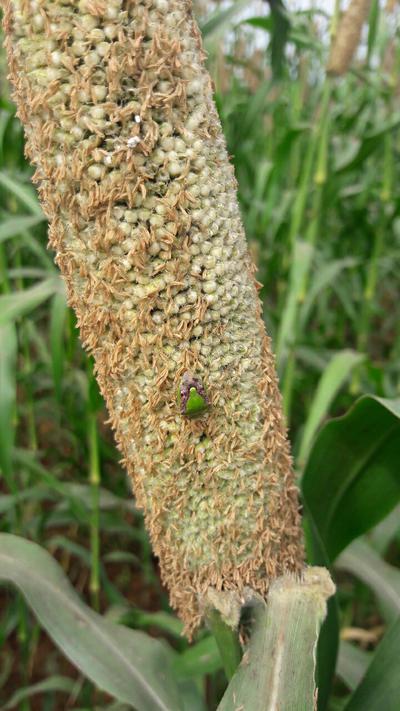Stink Bugs on Maize, Millet and Sorghum
Euschistus spp.
Insect
5 mins to read
In a Nutshell
- Rows of holes on leaves.
- Stunted growth.
- Plant deformation.
- Reduced yields.
- Brown stink bugs, triangular pattern on back.
Can also be found in
Symptoms
Stink bugs attack maize mainly during seedling or early vegetative stages. Seedlings may produce extra tillers (added branching) to compensate for the damage on the main stalk. The bugs feeding habit on leaves is characterized by a pattern of repeating equidistant holes or rows. The holes vary greatly in size but are usually oblong or elongated with a yellow halo surrounding them. A slimy, decaying area may be found in the stalk where the stink bug has fed. Heavily infested plants tend to have a deformed shape, stunted growth and poor yields. The ears may also show deformations, late maturation and often poor kernel filling. Stink bugs are very good fliers and spread readily between crops, causing consequent yield loss.
Recommendations

Organic Control
Parasitic tachinid flies and wasps lay eggs into the eggs of stink bugs and their larvae later feed on the hatching maggots. Birds and spiders can also help to reduce infestation. The oil of Eucalyptus urograndis is toxic to the bugs and their nymphs.

Chemical Control
Always consider an integrated approach with preventive measures together with biological treatments if available. Seed treatments with insecticides of the pyrethroids group may provide some control and avoid damage in seedlings. Foliar application of insecticides based on bifenthrin can also help to control populations.
What caused it?
The aspect of these bugs varies slightly depending on the species. Adults of the brown stink bug are shield-shaped with mottled brown, leathery wings and a characteristic triangular pattern on their back. Eggs are barrel-shaped and laid in clusters on the leaves. Nymphs are nearly round and black and wingless. Adults and nymphs damage the plant with their sucking mouthparts, piercing tissues and injecting substances to digest the content, then re-ingesting the dissolved plant material. This causes malformation or stunted growth, even more so if populations are large. On fruits and seeds, the feeding causes stains and imperfections that impact the quality of the product. Stink bugs have a wide range of alternative hosts like weeds and several grains crops such as soybeans, vegetables and alfalfa.
Preventive Measures
- Plant early to avoid peak populations.
- Barriers between fields can help to reduce the migrations of the bug.
- Monitor regularly and rid the field of weeds.
- Clear the field of plant residues after harvesting.
- No-tillage practices or the presence of mulch favors the risk of infestation.



